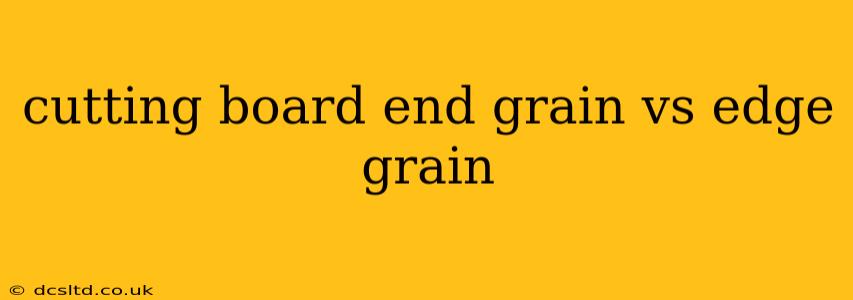Choosing the right cutting board can significantly impact your cooking experience and the longevity of your knives. Two popular types are end-grain and edge-grain cutting boards, each with its own set of advantages and disadvantages. This guide will delve into the key differences, helping you decide which best suits your needs and culinary style.
What is an End Grain Cutting Board?
End-grain cutting boards are made by arranging wood pieces so that the end grain—the cross-section of the tree—is exposed on the cutting surface. This creates a naturally porous surface with thousands of tiny wood fibers standing upright. These fibers act like tiny springs, cushioning the impact of your knife and significantly reducing the risk of blade damage.
Advantages of End Grain Cutting Boards:
- Superior Knife Protection: The most significant advantage is the unparalleled protection it offers your knives. The self-healing nature of the wood minimizes blade dulling and chipping.
- Self-Healing Properties: Minor cuts and scratches quickly close up, extending the board's lifespan and maintaining its hygienic condition.
- More Comfortable to Use: The slightly yielding surface makes chopping and cutting more comfortable on the hands and wrists.
- Better Stability: Heavier than edge-grain boards, they tend to remain stable on the countertop during use.
Disadvantages of End Grain Cutting Boards:
- More Expensive: Due to the construction process and the amount of wood required, end-grain boards are generally more expensive.
- More Maintenance: While self-healing, they still require more regular oiling and maintenance to prevent dryness and cracking.
- Can be More Difficult to Clean: The porous nature requires thorough cleaning and drying to prevent bacteria growth.
What is an Edge Grain Cutting Board?
Edge-grain cutting boards are constructed with the wood's long grain running parallel to the cutting surface. This means the knife slices through the wood fibers rather than between them. They are typically made from a single, wider piece of wood or by joining several smaller pieces edge-to-edge.
Advantages of Edge Grain Cutting Boards:
- More Affordable: Generally less expensive than end-grain boards due to simpler construction.
- Easier to Clean: The smoother surface makes them easier to clean and less prone to harboring bacteria.
- More Durable (in some ways): They are less prone to chipping and cracking, especially if made from hardwoods.
Disadvantages of Edge Grain Cutting Boards:
- Dulls Knives Faster: The harder, smoother surface causes more friction and can dull knives more quickly than end grain.
- More Prone to Scratches and Gouges: Knife marks are more visible and permanent on edge grain than on end grain.
- Less Comfortable to Use: The harder surface can be less forgiving on the hands and wrists during extended chopping.
Which Type of Cutting Board is Best for Me?
The best choice depends on your priorities:
- Prioritize knife sharpness and comfort: Choose an end-grain cutting board.
- Prioritize budget and ease of cleaning: An edge-grain board may be a better option.
- Professional Chefs: Often prefer end-grain for its knife-saving properties and comfortable cutting experience.
- Home Cooks on a Budget: An edge-grain board can be a perfectly functional and affordable alternative.
How do I care for my cutting board?
Regardless of the type of cutting board, proper care is crucial for longevity and hygiene. Regular cleaning, oiling, and avoiding prolonged exposure to water are essential for both end-grain and edge-grain boards. Always allow your cutting board to dry completely after washing.
What are the best woods for cutting boards?
Many hardwoods are suitable for cutting boards, including maple, cherry, walnut, and teak. Harder woods are generally more durable but can also be more expensive.
Are there other types of cutting boards besides end grain and edge grain?
Yes, there are also side-grain cutting boards, which are less common and generally not recommended for heavy use due to their tendency to dull knives quickly. Plastic and other non-wood materials are also popular choices.
This comprehensive guide provides a detailed overview of end-grain versus edge-grain cutting boards, addressing common questions and helping you make an informed decision based on your specific needs and preferences. Choosing the right cutting board is an investment in both your kitchen and your knives.
